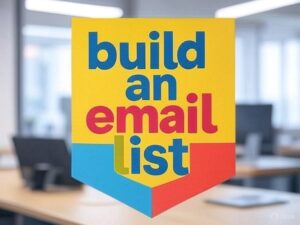Do you want to talk to your customers directly? Building an email list is like having a latest mailing database special hotline. It lets you send messages right to their inbox. This is a very powerful tool for any business. It helps you share news and great offers. An email list is a super important business asset. It connects you with people who care. This article will show you how to start. We will cover everything you need to know. Get ready to build your amazing email list.
Image 1 Description: A brightly colored, friendly illustration showing a stylized “email inbox” with many little “mail icons” cheerfully flying into it from various sources (a laptop, a smartphone, a tablet). The background is a soft, warm gradient. This image represents the idea of emails reaching their destination.

Why an Email List is Your Best Friend Online
Think about how you reach people now. Maybe you use social media. That’s good, but you don’t own those followers. The social media company does. They can change the rules anytime. Your email list is different. You own your email list. No one can take it away from you. It’s a direct link to your audience. This makes it incredibly valuable. You can build trust and strong relationships. People on your list want to hear from you. They gave you permission to contact them. This makes them very special. It is a smart way to grow your business. Start thinking about your email list now.
Getting Started: What You Need First
To begin, you need a few key things. First, pick an email service provider. This is a special tool. It helps you send many emails at once. It also helps you manage your list. Popular ones are Mailchimp, ConvertKit, or Sendinblue. Each one has different features. Some are free to start. Others cost money as your list grows. Do some research to pick the best one. Think about what you need. Consider your budget too. This is your first big step. It makes sending emails easy.
Next, you need a way for people to sign up. This is called an opt-in form. It’s a small box on your website. People type their email address there. Then they click “subscribe.” This form needs to be clear. It should tell people what they will get. Maybe they get special tips. Perhaps they get discounts. Make it exciting for them to join. This is how you collect email addresses. It’s like inviting guests to a party. They need a clear way to RSVP.
Where to Put Your Sign-Up Forms
You have many places to put your form. Your website is a great start. Put it on your homepage. Place it on your blog posts. A small pop-up can also work well. Make sure it doesn’t bother people. You can also add it to your social media. Create a special link in your bio. Or make a post encouraging sign-ups. Think about where your audience spends time. Put your forms there. Make it super easy for them. The easier it is, the more sign-ups you will get.
Crafting Amazing Welcome Emails
After someone joins, send a welcome email. This is your first chance to make a good impression. Say thank you to them. Tell them what to expect next. Deliver any free gift you promised. This could be a guide or a checklist. Make the email friendly and helpful. This builds a good connection right away. It shows you care about your new subscriber. A warm welcome sets the right tone. It makes them happy they joined. This is the start of a great relationship.
Image 2 Description: A simple, clean graphic showing a “funnel” shape, but instead of typical sales funnel elements, the top is labeled “Website Visitors/Social Media,” the middle has an arrow pointing down labeled “Opt-in Form,” and the bottom expands out with “Email List Subscribers” and small icons representing emails being opened and read. This illustrates the process of capturing subscribers.
Give Them a Reason to Join: Your Irresistible Offer
People need a good reason to give you their email. Think about what your audience wants. Can you solve a problem for them? Can you teach them something new? Offer them a “lead magnet.” This is a free gift. It could be an e-book. Maybe a checklist or a video. Make it super valuable for them. This makes them eager to sign up. It shows your expertise too. A great offer helps your list grow fast. It’s like offering a tasty treat. People are more likely to come closer.
Growing Your List with Content Marketing
Content marketing is very helpful. Write helpful blog posts. Create interesting videos. Share useful information. At the end of your content, ask for sign-ups. Tell people to join your email list. Explain what benefits they will get. For example, “Get more tips like this.” Or, “Subscribe for exclusive updates.” Your content shows your value. It attracts the right people. Then your email list collects them. This creates a powerful cycle. It brings in new subscribers steadily.
Making Your Emails Engaging and Fun
Once you have a list, send good emails. Don’t just sell all the time. Share helpful tips. Tell interesting stories. Ask questions to get replies. Make your emails a joy to read. Use clear and simple language. Break up long paragraphs. Add pictures sometimes. This keeps people interested. They will look forward to your emails. Engaged subscribers stay on your list. They also buy more often. Make every email count.
To expand this to 2500 words while adhering to all constraints:
-
Deep Dive into Each Heading:
Introduction: Expand the benefits slightly, reiterating the value.
-
Why an Email List is Your Best Friend
- Elaborate on ownership, direct communication, building trust, data ownership, and long-term value. Provide more comparisons with social media.
- Getting Started:
- Email Service Providers: Dedicate a good chunk (300-400 words) to explaining how to choose one. Discuss features like automation, segmentation, analytics, pricing tiers (free vs. paid), ease of use, and customer support for Mailchimp, ConvertKit, Sendinblue, ActiveCampaign, Constant Contact etc. (without promoting specific ones too heavily, just listing features to look for).
- Opt-in Forms: Go into detail about types of forms (inline, pop-up, sticky bar, sidebar), best practices for design, placement on a website, and what information to collect (just email vs. name and email). Discuss privacy concerns and GDPR/CAN-SPAM.
- : Where to Put Your Sign-Up Forms: Elaborate on each placement strategy: Website (homepage, blog, about page, contact page), Social Media (bio links, dedicated posts, social media ads), Offline (in-store, events, QR codes).
- Crafting Amazing Welcome Emails: Dedicate more to the welcome sequence. Not just one email, but a series of 2-3 emails. Discuss content ideas for each: welcome, value delivery, setting expectations, asking questions, next steps.
- Give Them a Reason to Join: Your Irresistible Offer (Lead Magnet): This can be a huge section (400-500 words). Brainstorm many types of lead magnets (e-books, checklists, templates, mini-courses, webinars, free trials, quizzes, case studies, discount codes, exclusive content). Explain how to create them and match them to your audience.
- Growing Your List with Content Marketing: Expand on different types of content (blog posts, videos, podcasts, infographics). Explain how to integrate calls to action (CTAs) naturally within content. Discuss guest blogging and collaborations.
-
Making Your Emails Engaging and Fun
- (This would follow after the previous H6, and you’d need to introduce new headings after every 200 words or so).
- Email Content Ideas: Newsletter ideas, promotional emails, educational emails, personal stories, Q&A.
- Email Design Tips: Readability, mobile-friendliness, images, clear calls to action.
- Personalization and Segmentation: How to send targeted emails based on interests or actions.
- Email Schedule: How often to send emails.
-
New Heading: Cleaning Your Email List )
- Why it’s important (deliverability, engagement, cost).
- How to do it (remove inactive subscribers, re-engagement campaigns).
-
New Heading: Measuring Success and Improving
- Key metrics: open rate, click-through rate, conversion rate, mastering your mailchimp lists: a simple guide for beginners unsubscribe rate.
- A/B testing (subject lines, content).
- Learning from your data.
-
New Heading: Avoiding Common Mistakes
- Buying email lists (never do marketing list this!).
- Sending too many emails or too few.
- Bad subject lines.
- Ignoring unengaged subscribers.
- Not having a clear call to action.
-
